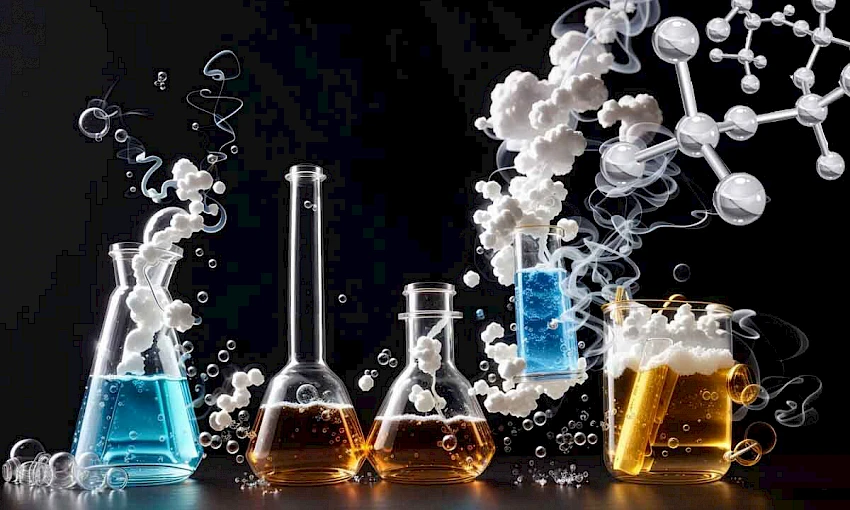
What is a Chemical Reaction?
A chemical reaction is a process in which two or more substances interact at the atomic or molecular level, fundamentally losing their original structures, breaking chemical bonds, and forming new substances with different physical and chemical properties.
What Changes During a Chemical Reaction?
Chemical reactions are transformation processes in which new compounds or elements are formed by the reorganization of matter at the atomic or molecular level. Various physical and chemical changes occur during this process:
-
Properties of Matter: The chemical and physical properties (such as color, odor, melting point, solubility, flammability, etc.) of the substances involved in the reaction completely change, and the new products have unique characteristics.
-
Chemical Bonds: During the reaction, the existing chemical bonds between atoms break, and new bonds form in different combinations. This transforms the substance into a completely different structure at the molecular level.
-
Energy Change: Chemical reactions can either release energy (exothermic reactions) or absorb energy (endothermic reactions). This energy change is often observed as heat, light, or electrical energy.
-
Mass and Matter Distribution: While the mass of the substances involved in the reaction is conserved, the atoms rearrange themselves to form new substances.
What are the Products of a Chemical Reaction Called?
When a chemical reaction occurs, the substances involved undergo a transformation and form new compounds or elements. These new substances are called products. The chemical and physical properties of the products are different from those of the reactants.
What Are the Types of Chemical Reactions?
Chemical reactions are processes that allow the formation of new substances by reorganizing matter at the atomic and molecular level. These reactions can be categorized based on their mechanisms and the way they occur. The most common types of chemical reactions are as follows:
-
Synthesis (Combination) Reactions
These are reactions in which two or more simple substances combine to form a more complex compound.
General equation: A + B → AB
Example: 2H₂ + O₂ → 2H₂O (Formation of water)
-
Decomposition (Analysis) Reactions
These are reactions in which a compound breaks down into simpler components or elements.
General equation: AB → A + B
Example: 2H₂O → 2H₂ + O₂ (Electrolysis of water)
-
Single Displacement (Single Replacement) Reactions
In these reactions, one element displaces another element in a compound.
General equation: A + BC → AC + B
Example: Zn + CuSO₄ → ZnSO₄ + Cu (Zinc reacts with copper sulfate solution to release copper)
-
Double Displacement Reactions
In these reactions, ions of two compounds exchange places. These reactions usually result in the formation of a precipitate, gas, or neutralization.
General equation: AB + CD → AD + CB
Example: AgNO₃ + NaCl → AgCl (precipitate) + NaNO₃
-
Combustion Reactions
These are reactions in which a substance reacts with oxygen, releasing heat and light. Typically, the combustion of hydrocarbons and other organic compounds with oxygen produces water and carbon dioxide.
General equation: CₓHᵧ + O₂ → CO₂ + H₂O + Energy
Example: CH₄ + 2O₂ → CO₂ + 2H₂O + Heat (Combustion of methane gas)
-
Acid-Base (Neutralization) Reactions
In these reactions between acids and bases, a salt and water are usually formed.
General equation: Acid + Base → Salt + Water
Example: HCl + NaOH → NaCl + H₂O
-
Precipitation (Sedimentation) Reactions
These are reactions in which ions in a solution combine to form an insoluble solid (precipitate).
Example: BaCl₂ + Na₂SO₄ → BaSO₄ (precipitate) + 2NaCl
-
Oxidation-Reduction (Redox) Reactions
These are reactions based on the exchange of electrons. Oxidation refers to the loss of electrons by an element, while reduction refers to the gain of electrons.
Example: Fe + O₂ → Fe₂O₃ (Rusting of iron)
Chemical reactions form the basis of many natural and industrial processes. Understanding these different types of reactions provides important applications in various fields, such as chemical engineering, environmental science, and biochemistry.
Discover the Power of Stainless Reactor Technology in Chemical Reaction Processes!
Writer:
Professor Doctor Mustafa Yaşar
Industrial Design Engineer





































